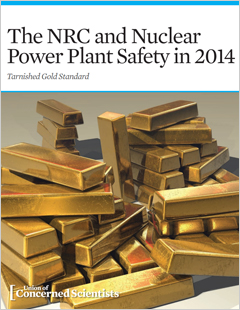The Nuclear Regulatory Commission (NRC) is the arm of the federal government charged with enforcing safety regulations at U.S. nuclear power plants. Since 2010, we’ve analyzed the NRC’s performance every year, highlighting both positive and negative safety trends.
Encouragingly, 2014 contained fewer near misses at U.S. nuclear power plants than any prior year we’ve reviewed, with only nine safety and security incidents prompting investigation (compared to ten in 2013, and fourteen the year before). However, the NRC continued to enforce a number of regulations inconsistently, and masked many of those inconsistencies by improperly hiding information from public inquiry. Poor treatment of several whistleblowers also highlighted an internal safety culture that needs improving.
Hidden information
In response to the terrorist attacks of September 11th, 2001, the NRC revised their processes for communicating with plant owners. If owners submit documents containing sensitive information, the NRC’s revised regulations help prevent public disclosure.
Since passing these revised rules, the NRC has proceeded to withhold substantial amounts of safety-related information, including virtually all documents received from nuclear power plant owners about fire protection and emergency planning procedures. Some of these documents were requests for license revisions and exemptions from federal safety regulations, and many requests were approved. Yet despite directly impacting public safety, these approvals and exemptions were granted without any attempt at transparency.
Withholding information on the basis of security concerns has its place. Yet none of the hundreds of fire protection and emergency planning documents withheld by the NRC were requested to be hidden by plant owners. And when the documents were released in response to repeat Freedom of Information Act requests, only personal information was redacted. A more effective regulator would welcome public transparency and end the practice of unnecessarily withholding safety-related information.
Punishing whistleblowers
Since 2008, at least two veterans of the nuclear industry and the NRC have legally raised legitimate safety concerns. Both have also been subjected to multiple investigations by the NRC and, despite never being found of wrongdoing, now face significant barriers to their careers.
In one case, a risk analyst with the NRC publicly expressed concerns about flooding risks at South Carolina’s Oconee plant. In another case, an NRC inspector at California’s Diablo Canyon plant submitted several non-concurrence reports, disagreeing with the NRC’s conclusion that Diablo Canyon was suitably prepared for an earthquake. In both cases, the NRC responded with harassment, intimidation, and investigation—perpetuating a self-protecting safety culture that stigmatizes whistleblowing at the expense of public wellbeing.
Fewer near misses
In 2014, the NRC responded to nine safety and security “near misses,” defined as events that increased the risk of reactor core damage by at least 10 times. Both the number of near misses and their severity have decreased in recent years: 2014 had the fewest near misses of any year since this series began, and all of 2014’s near misses were of relative low severity.
The NRC should continue its good work in reducing the number of these incidents, striving for consistency and transparency as it enforces its regulations.




